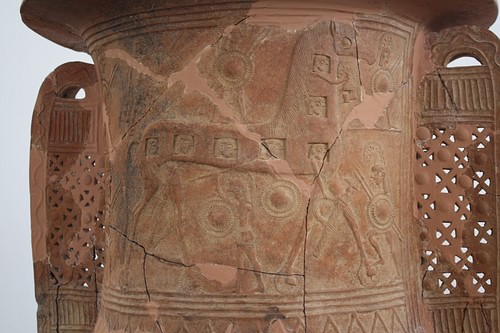

But the blind poet did not limit himself to the struggle of the Achaeans before the walls of Troy. The palace of Nestor at Pylos is yet additional evidence that Homer described events that had a historical foundation. The remains of Troy and various other discoveries of this century by archeologists have confirmed the fact. So the Trojan War did in fact take place. Troy was then subjected to the fate awaiting all sacked cities at the time, for it was put to flames, and those inhabitants who were not massacred became the slaves and servants of the victors. At nightfall, the hidden warriors emerged, opened wide the gates of Troy through which the Greek forces entered, having secretly returned with their ships. Despite the warnings of Cassandra and Laocoon, the Trojans dragged the horse into the city and because of its size tore down part of the walls to accommodate it. Then the Greeks set sail in their ships and departed. They built a huge wooden horse within which were hidden a number of Greek warriors. In the course of the ten-year war many of the heroes perished including Achilles, Patroclus, and Hector, but the Greeks were able by a ruse to capture the city. On the side of the Trojans Hector stands out together with the leaders of their allies who included the Lycians, Mysians, Pelasgians, Phrygians, Cicones, Paphlagons, Carians, Thracians, and others. On the Greek side the heroes who distinguished themselves were Achilles, Odysseus, the two Ajaxes, Diomedes, Nestor, Neoptolemus, Menelaus, Agamemnon, Palamedes, Philoctetes, and Patroclus. The Trojans rejected the demands of the Achaeans to return Helen and hostilities resulted. The Achaeans landed in Asia Minor in the course of which Protesilaos became the first casualty of the expedition.


1186 ships carrying some 120,000 men set off to bring Helen back or to conquer Troy if the Trojans refused to surrender the wife of Menelaus. To avenge the insult, the Achaeans assembled at Aulis and under the supreme leadership of Agamemnon, King of Mycenae, they set sail for Troy, but only after Agamemnon had sacrificed his daughter Iphigenia at Aulis to obtain a favourable wind. It was actually a harshly fought war between the Achaeans or Achawans and Aeolians on the one hand, and the Dardanians, on the other, when the former hoped to colonize the coasts of Asia Minor.Īccording to the myth, the cause of the war was the abduction of Helen, wife of Menelaus the king of Sparta, by Paris, son of Priam, King of Troy. Thus the Trojan War is no longer a fancy but an historical event of major importance. The Discovery of the remains of Troy VII by the archeologist indicated without a doubt that the city in fact had been destroyed by a terrible conflagration resulting form enemy conquest. But modern historians until the remarkable discovery by Schliemann of the walls of Troy, believed that it was a product of the imagination of the Greek and Latin poets. The historian Herodotus and Thucydides believed that the war had in fact taken place. The Trojan War was fought by the Greeks and Trojans and lasted for ten years between 11 B.C.


 0 kommentar(er)
0 kommentar(er)
